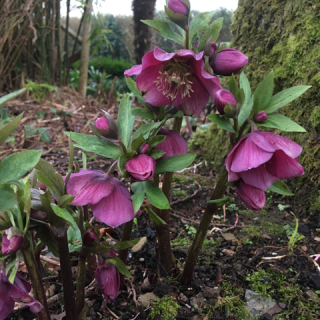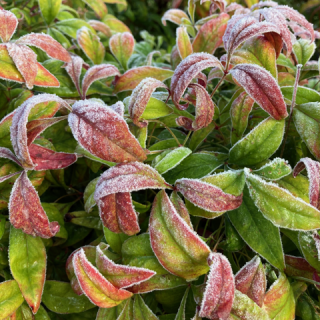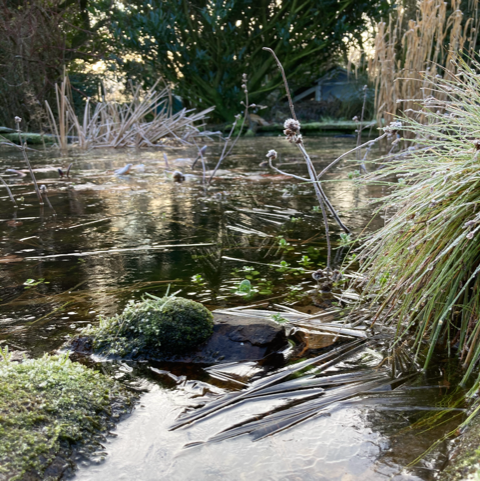“Chill December brings the sleet,
Blazing fire, Christmas treat”
Sara Coleridge
This is the last verse of the poem ‘The Months’, and this year it may be rather true. We have a proper cold snap forecast this week and next. Forecasters don’t know how long it will last for, but they do all seem to suggest it may even bring snow. Whether this means for us as well is doubtful, but sleet we may well get!
This really has been a year of clear-cut seasons. Blazing hot and dry summer, one of the wettest autumns for a long time and now cold, relatively dry and frosty, but with the chance of snow.
So if you have not yet wrapped up any plants whose hardiness is doubtful, do this as soon as you can. Bring in any pots, or put them under cover for protection. Raise others off the ground by putting them on pot feet, so the water can drain out and the pot also stands less chance of freezing.
This autumn I planted a baby schefflera (given this variety can reach 2.5m, my little 20cm plant is very much a baby). When young they are susceptible to cold winds and frost, but we’ve had a series of relatively mild winters so I thought it would be alright. I have spent today making a little horticultural fleece teepee for it.

A cold snap means looking after the wildlife too. Making sure there is fresh water available at ground level for not just birds, but a variety of other creatures as well. Do scrub out and clean waterers every day if you can, and clean feeders as well. Avian flu is still with us and can be passed on at drinking stations in particular.
There are many plants that can provide food for wildlife over the winter if it’s hard to leave their gourmet seed, mealworm and fruit selection out each day! Crab apples are one of the best to plant for wildlife, we had fieldfares feeding on our bumper crop this year. Hawthorn, ivy, cotoneaster, dog rose and holly provide  wonderful berries and hips, plus ivy will flower in the winter providing nectar on warmer days for any emerging bees. Mahonia, hellebores, early snowdrops, winter aconites, primroses and winter-flowering clematis varieties look beautiful as well as being a source of nectar.
wonderful berries and hips, plus ivy will flower in the winter providing nectar on warmer days for any emerging bees. Mahonia, hellebores, early snowdrops, winter aconites, primroses and winter-flowering clematis varieties look beautiful as well as being a source of nectar.
Trees and shrubs
Broadly speaking, any deciduous tree or shrub can be pruned in the winter while it is dormant. Except for Prunus species – these include stone fruits such as cherry, plum, apricot, and ornamental or Japanese cherries. Pruning them in winter can leave them susceptible to infection by silverleaf, a fungal disease.
Although apples can also get silverleaf, pruning in winter does not seem to make them any more susceptible to it, so apples should receive their winter pruning from December onwards. Pears too. Acers should be pruned now as well; if they are pruned while growing they will bleed profusely. It is better to choose a day when dry weather is forecast for a couple of days though, to allow the cuts to dry.
Unless the ground is frozen, both bareroot and containerized trees and shrubs can be planted. It’s a great time to walk around the garden and see if there are any gaps that would suit an evergreen, or another type of shrub with winter interest, for example berberis or pyracantha for berries, viburnum for winter flowers, a topiary ball or low, clipped hedge.
 Caption: Heavenly bamboo is a great colourful evergreen plant for winter
Caption: Heavenly bamboo is a great colourful evergreen plant for winter
It’s also a good time to start mulching to give the trees the best chance for next year. Adding organic matter is a very useful way of retaining more moisture during the summer. If you have fruit trees, make sure the area around the base is free of weeds that will compete with the tree, and lay a good 3” covering of mulch anything up to a metre in radius around the trunk, but do not let it touch the trunk itself as this can cause it to rot.
If you would like to try your luck with growing any hardy shrub or tree from seed, plants them now and leave them out in a dry but outdoor area, a covered porch or a cold frame. Many plants need winter cold to break their dormancy and if they don’t get it you may have to put them in the fridge!
The same goes for many hardy herbaceous plants such as hellebores and echinacea. These can be very frustrating to try and grow, but if you sow them in moist (not wet) compost in late autumn and leave them outside, under a cover so they do not get too wet, and not much sun, the natural cold temperatures of winter will do the job for you. Uncover them when temperatures begin to rise in spring so the germinating seedlings can grow.
Herbaceous borders
You can continue planting tulips up until Christmas, although I’ve sometimes planted them in the quiet days in between Christmas and New Year with no harm. Even daffodils don’t seem to mind such late planting, although they may flower a little later in their first year than they usually would.
There is not a huge amount of work to do in the herbaceous border in December, in fact, sometimes it’s better to do absolutely nothing and leave old stems for winter protection, insect hideaways and winter interest – although I have to admit the latter works wonderfully in parts of the country that are cold and dry. Frosted flower heads and golden grasses. For us, it’s often wet and windy so everything collapses into a sodden mess! But it still makes a good winter home for wildlife.

Root cuttings can still be taken from plants such as oriental poppies, mint, verbascum and acanthus, although keep the new plants under cover if you can until they are established. And if the ground is not frozen, potted hardy plants can be planted at any time.
The productive garden
Harvest continues with abundance, although you may be getting a little fed up with brassicas! If you have anything stored from the autumn, such as apples or squash, do keep an eye on them regularly and remove any that might be going bad.
If you have room in the greenhouse you can continue sowing leaves such as lamb’s lettuce and mustard greens. Broad beans can be started in long pots that will accommodate their roots – homemade pots from tubes of newspaper, or even the cardboard middle of toilet rolls, can be useful for this.
Prune blackcurrants and gooseberries now. To prune blackcurrants, cut a quarter to a third of the oldest stems right back down to the base. Take out any weak shoots and those that sprawl or are low down. Remove any dead stems. If your plants were planted within the last year or two, only prune them lightly unless the stems are a bit weak, in which case cut at least half of the shoots down to the base.
For gooseberries, prune all the side shoots back to 1 to 3 buds. Take the main branch shoots back by one quarter. Trim out any low down shoots, weak stems, dead wood and anything pointing in the wrong direction. If the bush is congested, take out some stems from the centre to open the bush up into a goblet shape.
Both of these may sound complicated but if you just remember that blackcurrants fruit on last year’s wood, and that gooseberries just need an overall trim, they’ll be fine.

Caption: Snowdrop ‘Mrs Macnamara’ always starts flowering before Christmas
Caroline Kenzie

